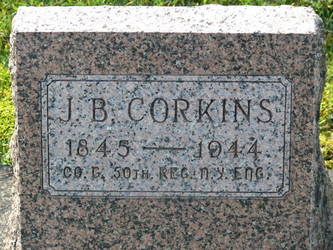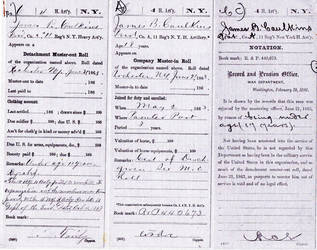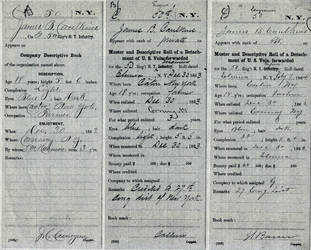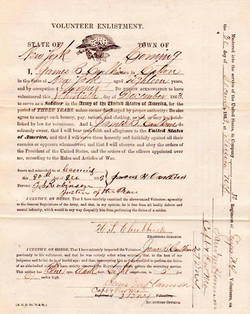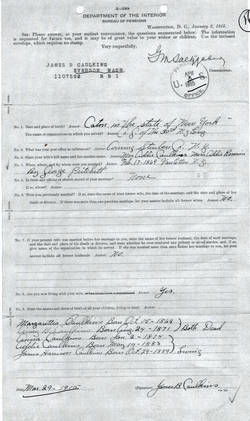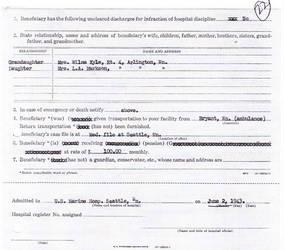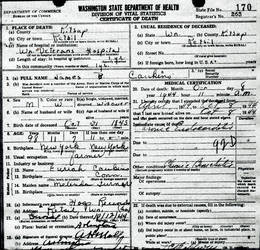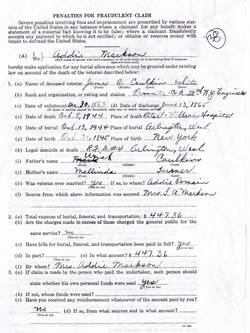James B. Caulkins
Representing: Union
G.A.R Post
- E. M. Stanton Post #86 Arlington (Haller City), Snohomish Co. WA
Unit History
- 11th New York Heavy Artillery A
- 4th New York Heavy Artillery I
- 50th New York Engineers G
Full Unit History
11th NEW YORK VOLUNTEER HEAVY ARTILLERY
Organized: February, 1663 (beginning)
Mustered In: Never Mustered into Federal Service
Transferred: 7/23/63
4th NEW YORK VOLUNTEER HEAVY ARTILLERY
Organized: 12/1/61 New York, New York
Mustered In: Inf. Not Avail.
Mustered Out: 9/26/65 Washington D.C.
50th NEW YORK VOLUNTEER ENGINEERS
Organized: Summer/Fall, 1861 Elmira, NY
Mustered In: 9/18/61 (Inf.) and 10/22/61 (Eng.)
Mustered Out: 6/14/65 Ft. Berry, VA
Regimental History
REGIMENTAL HISTORY: (11th/4th)
*****NOTE: Roots of the 11th begin with the 4th. While James Caulkins enlisted in the former, likely because of his young age, the muster officer would not admit him into Federal service. Although technically not in either organization he would note both in his latter year’s pension papers and military service records do exist pertaining to his contact with the 11th/4th. For these reasons the brief history of the 11th /4th as it pertains to James is presented herein while a complete history is not.
On February 7, 1863, Captain William B. Barnes, 4th artillery, was appointed Colonel, and authorized to recruit a regiment of heavy artillery to be designated the 11th New York with headquarters located at Rochester, NY. On July 1, 1863, the companies then organized were formed into a battalion (at least three or more companies plus headquarters). The organization of the regiment, though continued, was not completed - the authority under which Colonel Barnes acted, having been revoked on July 25, 1863. The four companies thus far organized; "A", "B", "C" and "D" were then ordered to be transferred to the 10th NYHA, but a few days later those orders were changed to the 4th. The 4th itself, having been formed in late 1861, served throughout the War receiving final muster in September, 1865.
REGIMENTAL HISTORY: (50th)
The 50th, an "eastern-theater" regiment, was formed from companies raised from the middle and western parts of the State of New York. Initially known as "Stuart's Regiment", the unit began its existence as an infantry organization that left the state for Washington, D.C. where, on October 22, 1861. Once in Washington City the unit was converted by the War Department into a regiment of engineers and the men received instruction on their new duties.
In March, 1862 the engineers moved to Yorktown, Virginia where they toiled faithfully digging siege trenches, constructing bridges, earthworks, etc. until the Rebel evacuation of that city. At White House, VA the command was divided into several detachments which were engaged in escort and bridge building duties until being reunited on June 1st to concentrate on specifically building bridges for the passage of Union troops over the Chickahominy River. It then accompanied the Army of The Potomac through Union Gen. McClellan’s' Seven Days Battles during the Peninsula Campaign. When that campaign ended at Harrison's landing, the regiment was again divided until reunited at Washington City in September. The unit then focused on the construction and transportation of bridge pontoon boats which were utilized in the crossing of the Rappahannock River in December prior to the battle of Fredericksburg, VA. During the laying of three bridges the 50th was under continuous fire from enemy sharpshooters.
Here it should be noted that prior to July 17, 1862, the 50th was on state records as an infantry unit. However, an Act of Congress of that date accepted it as a regiment of the volunteer engineer corps with the same rank and standing as the regular army engineer corps.
After spending the winter of 1862-'63 near Fredericksburg the regiment joined the May Chancellorsville Campaign where it participated in once again conveying the Army across the Rappahannock river and was praised highly for its actions. In June at Deep Run it suffered the loss of 11 killed wounded and missing while engaged in laying a bridge.
Later that summer companies "A, "C", "F", "G", "H" and "K" remained in the field while the remainder of the regiment was stationed in Washington City. In December approximately three quarters of the regiment reenlisted and were granted veteran furloughs.
1864. In May Union Gen. U.S. Grant's Overland Campaign moved Federal forces into Virginia opening a drive that months later would bring an end to four years of bloody civil war. With the onset of this campaign the 50th was once again assigned in detachments. Those accompanying the Army of The Potomac were busy laying bridges to support the southward movement. The most significant of these was a 2010 foot span across the James River.
Once Union forces attacked and laid siege to Petersburg, VA the unit was in great demand at all points to build and reconstruct fortifications. At times the 50th even helped destroy railroads. During its long service the volunteer soldiers became very proficient in engineering and through this steadiness under fire it is said to have lost during the last year of its service no bridge-building material of any kind. Participation in the Grand Review at Washington, D.C. preceded final muster.
Regimental losses: Officers killed or Mortally wounded = 1; Officers died of disease, accidents, etc. = 1;
Enlisted men killed or mortally wounded = 19; Enlisted men died of disease, accidents, etc. = 206.
*NOTE: The veteran considered herein appears to have entered this world with the surname Caulkins. When he left this world his headstone reflected Corkins. Why the change was made along life's journey is not known.
|
|
Soldier History
SOLDIER: (11th/4th)
Residence: Inf. Not Avail. Age: 17.7. Yrs.
Enlisted/Enrolled: 5/2/63 Painted Post, NY Rank: Pvt.
Mustered In: Rejected by muster officer, Rochester, NY
Discharged: 6/21/63 Rochester, NY
Highest Rank: No Rank
SOLDIER: (50th)
Residence: Inf. Not Avail. Age: 18.2 yrs.
Enlisted/Enrolled: 12/30/63 Corning, Steuben Co., NY Rank: Pvt.
Mustered In: 12/30/63 Corning, Steuben Co., NY
Mustered Out: 6/13/65 Ft. Berry, VA
Highest Rank: Pvt.
Family History
Family History
James B. Caulkins was reportedly born 10/31/45 in New York State. Locations of his birth have been noted as either Erwin/Ervin, or more often, Caton. None of these designations appear on a modern-day map.
Parents of young James were Uriah (b. 1790 CT) and Melinda/Mellinda (no b.d. nee Turner) Caulkins. No further birth family information has been found.
Beyond, James' birth information, the next family notation appears from 5/2/63 in Painted Post, New York when young James - as well as his father, Uriah - enlisted into Captain Church's company/battery "A" of the 11th New York heavy artillery. At enlistment James' vital statistics were noted as follows: 5'5", blue eyes, light complexion and brown hair. His occupation was note as "farmer."
The 11th, failing to meet recruiting quotas to fill its ranks, was sometime between 5/2 and 6/2/63 collapsed into the 4th New York heavy artillery within which Church's company/battery "A" became company/battery "I". The 4th and company/battery "I" was mustered into Federal service, apparently at Rochester, NY on 6/21/63. It was in that location and on that date that military service began to go askew for the aspiring Private James Caulkins. Whether because of his father was having second thoughts about his young son facing the privations of Civil War army life or some other reason, 17 year old James was refused Federal muster. Whatever the circumstances, a few months later, in Corning, Steuben County, NY Uriah attested that James was by that time 18 years old - legal age for entrance into the military with parental permission - and gave his consent for his son to enlist. The enlistment, however, was not in his regiment, the 4th NY heavy artillery, but in Captain Taylor's company "G" of the 50th New York Engineers. James was, finally, officially a private in the U.S. Army.
For answering his country's call James received a $300 enlistment bonus or "bounty", $60 of which was paid up front with the remainder to be received in installments. He also received $13 (one month's) advanced pay and a $2 "premium." For delivering him to the enlistee rendezvous depot in Elmira, NY on 2/2/64 his recruiting agent was entitled to a $15 "premium." From Elmira it appears James travelled to Washington, D.C. and, from there joined his regiment somewhere in the field.
Although James' company muster records are missing between May and November, 1864, likely he was present for duty as he was so noted in Mar/Apr. '64 and once again in Nov. /Dec. '64. This pattern continued until 6/4/65 when - with the War having ended - James was sent to the regimental hospital for one day because of an undescribed ailment. Shortly thereafter, on 6/13, James' military career came to an honorable end.
It appears that after being separated from the service James returned to New York. Exactly where, however, it not documented. His next sighting is on 2/17/69 in the south central NY Tioga County community of Van Etten when he married one Addie Romain (b. bet. 1850-1853 NY). The union would produce five children: Maggie A. (b. 1871 NY), Amy/Amey B. (b.1871/'72 NY), Anna A. (b. 1874 NY), Addie (b. 1883 WI) and James Harrison (b. 8/29/89 WI).
As noted the locations of James' and Addie's offspring being born, the family moved from New York to Wisconsin at some point after daughter Anna's 1874 birth. The census for 1880 placed the young family consisting of James, Addie and their three daughters in Augusta, Eau Claire Co., WI where James' occupation was noted as "farm laborer." Interestingly, this is the first documental instance of the surname Corkins appearing.
Document ally, where the Caulkins/Corkins (from here on Corkins will be used) family was residing at the time of the 1890 census is not known as most of the results of that population tally was destroyed by fire. As noted earlier, however, in 1889 they were still in Wisconsin, so likely that is where they had remained.
1900. By the time of this census the Corkins had exited Wisconsin and were residing in Cleveland, Le Sueur Co., MN with James stating his occupation as "day laborer." In this census Addie stated that she had borne five children, three of whom were then living. Two of those three, Addie and James, were then residing with their parents.
Exactly when and why the Corkins left Minnesota is not known. What is documented is that by sometime in 1906 the family was residing in Standell, Whatcomb County, near the city of Bellingham, Washington State. Already receiving a U.S. Government disability pension based on continuing ailments which he traced back to his Civil Warring days, sixty year old James was seeking an increase of his stipend to ten dollars per month based on having a "bad stomach for three years" because of a constantly painful ulcer as well as rheumatism in his back. While it is not documented, likely that increase was granted as were further raisings to $16 in mid-1912, $20 in October, 1915 and $24 in 1920. By 1940 that stipend had grown to a princely $100 per month.
The census for 1910 found James, wife Addie and children Addie and James - plus a Lewis Markson (b. 1882 Norway) - residing in the Whatcomb County community of Roedner – a name which no longer exists. Four years later, in February, 1914 they were still in Whatcomb County, but by then living in the small community of Everson near the U.S./Canadian border. Six years later, however, at the time of the 1920 census, James and Addie were found south of there in the small Snohomish County community of Bryant. By that time James, then aged seventy five years, was noted as having "no income."
A decade later. The year was 1930. Time for another census. James' address was still Bryant, but by that date Addie had passed away. The cause of her passing and her final resting place are not known. Widower James was residing in the home of his now son-in-law Lewis Markson and wife, Addie, the latter being James' daughter.
On July 1, 1936 a representative of the pension system visited James in Bryant - which he characterized as "not much more than a wide spot in the road about 10 miles from Arlington." The report which followed read, in part, as follows: "When the examiner visited he (James) was away visiting friends in Bellingham. He is past 90 years age. (He) owns his own home. His ganddaughter and husband live with him. Residents of Bryant know him very well and speak highly of him. They say he gets around like a man of not more than 60 years of age; that he frequently goes away from Bryant to visit friends....He is well physically and mentally alert...always well clothed and apparently is able to attend to his own business affairs. They did not know of any problems. Diagnosis: Although (I) did not contact veteran, from information secured it would indicate he is receiving the benefits of his pension and is well cared for, content and happy in his surroundings."
Note: As of this writing census data from 1940 has not been released by the U.S. Government. As we shall see, however, James remained in Snohomish County near Arlington.
In late winter/early spring months of 1943 James' health began to deteriorate. A cough of two weeks first landed him in the hospital at Arlington before, in early June, he was transported by ambulance to the U.S. Marine Hospital in Seattle. His diagnosis at that time included not only the persistent cough, but senility. A few weeks thereafter he was transferred from the Seattle facility to the Soldiers' home in Retsil, Kitsap County, Washington. There his diagnosis was characterized as "Negative history until a few months ago. Lived with relatives or (a) housekeeper. Chronic bronchitis, failing eyesight, hearing and memory. Physically very good for age. Small right rupture, chronic procial trouble. Senility. Disabled from any work."
Old soldier James Caulkins/Corkins died at in Retsil on 10/8/44 at the age of 98 years and 11 months. As his address at death was still considered to be Arlington, his burial was in the Arlington community cemetery.
Cemetery
Buried at Harwood Cemetery Arlington
Row: 142
Site: 3
